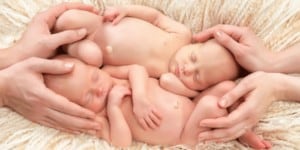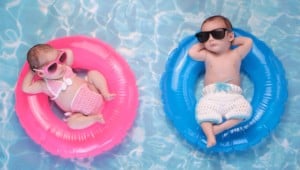What are Mirror Twins - Amazing facts through the Looking Glass
-
Author: Amar Kirale
- >> Post Created: August 28, 2020
- >> Last Updated: November 25, 2024
Medically Reviewed by: Dr. Veena Shinde (M.D, D.G.O, PG – Assisted Reproductive Technology (ART) from Warick, UK) Mumbai, India

Mirror Twins - Table of Contents
Twins have become fairly common. I am sure you must have come across at least one pair of identical and fraternal twins during your life span. Since 1980, the number of twins’ birth have increased by around 75%. Which means around 1 set of twins in about 30 births. This is primarily due to assisted reproductive techniques and advancements in this field.
About 25% of these twins are even more unique. They are “Mirror Twins.” Mirror Image Twins or Mirror Twins always fascinated me during my research, when my wife was pregnant with Triplets. I had come across this topic in my online searches and few books too. This was my homework to prepare for what was to come.
Hence, thought of sharing with you the knowledge gathered on ‘Mirror Twins’ or ‘ Mirror Image Twins,’ to understand this type of twin better.
How are Mirror Twins Born?
We have understood that identical or monozygotic twins are born when one zygote splits in two. Usually this happens during the first week of conception.
Mirror image twins on the other hand are born when the zygote splits a little later than the first week. By this time the developing embryo has determined the left and right side. So when the zygote splits both the embryos will already have a different side and, therefore, will be opposite and asymmetric.
Mirror twins can be called lucky, because if the zygote had split even later, then it would have resulted in conjoined twins. So they are in that sweet spot where the embryo split before the time that could result in conjoined twins.
Read this next
Identical vs. Mirror Twins & What are Mirror Twins?
There is a common misnomer that mirror twins are another type of monozygotic twins, i.e., one-cell twins. But technically, mirror image twins are a subtype of identical twins.
Identical twins are born when one egg is fertilized by one sperm forming a zygote that later divides to form two babies. As these babies are from the same egg they are called monozygotic or one-cell twins.
Then what are Mirror Twins?
Mirror image twins are monozygotic twins with the difference that they are mirror images of each other. For e.g., one twin will have a birthmark on the left hand, whereas the other twin will have it on the right hand; dimples can be on opposite cheeks; freckles and moles can be in opposite places; etc. So even though they are monozygotic, they have asymmetric features and characteristics.
The effect of such asymmetry is that if both of them stand facing each other, it will look like each twin is a reflection of the other. Therefore, they are called mirror image twins.
Can you Test to Identify Mirror Image Twins?
A simple DNA test can help you identify whether the twins are identical or fraternal. But there is no test yet that can help determine whether the identical twins are mirror image twins or not.
Mirror twins or mirror image twins are solely identified based on the opposite characteristics that they portray.
Some very rare mirror image twins even have their internal organs in opposite places. This opposite orientation of internal organs is called situs inversus. If any mirror twin has this condition then it can be identified through X-ray, CT scan, MRI, or ultrasound.
Common Asymmetric/Opposite Characteristics of Mirror Twins
Mirror twins can have many characteristics that are opposite to each other. They can be of the following types:
Physical Characteristics
This is the most common way to identify mirror twins, as they portray same physical features that are on the opposite sides of their body, like birthmarks, moles, freckles, dimples, eye shape, nose shape, ear shape, eyebrow shape, cowlicks, hair whorls, hairlines, etc. They will look like mirror images.
Functional Characteristics
These characteristics go beyond just the physical aspects. Like, in some mirror twins, one twin can be left-handed, whereas the other is right-handed; they may cross legs that are opposite to each other; they will sleep on the opposite sides of the bed; while walking, one will lead with the right foot, whereas the other will lead with the left foot; etc. These functional characteristics may not always manifest, but are commonly seen in mirror twins.
Psychological Characteristics
Mirror twins can also show opposite interests, likes and dislikes, career options, sexual orientations, temperaments, etc. This deviation in psychological characteristics may be because of brain hemisphere dominance. Different hemispheres of the brain control different functions and thought processes. It is said that if the right hemisphere is dominant the person is more creative and intuitive, whereas if the left hemisphere is dominant the person is more analytical and logical.
Medical Characteristics
Many medical conditions can manifest in opposite sides in each mirror twin. For e.g., they can have the same eye condition but in opposite eyes, their teeth may start growing from opposite sides, cancer can develop in different sides of the lung, etc. An extreme case of mirror twins is situs inversus, where the placement of the internal organs is completely reversed in one. The heart, liver, lungs, stomach, etc. will be on the opposite side as compared to the normal anatomical orientation.
Final Thoughts
Most mirror image twins identify as identical twins as the term mirror twins or mirror image twins is not that well known. But the phenomenon of mirror twins is fairly common in identical twins. As there is no test that can determine whether your little ones are mirror image twins, the best way to identify mirror twins is to just look in the mirror.









